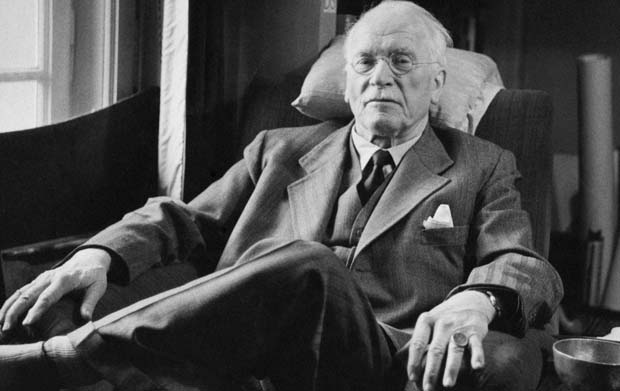To understand the ‘psychology’ behind the ways of the wizard, perhaps we should have a brief look at the work of the eminent Swiss philosopher, psychologist and psychiatrist Carl Gustav Jung, (1875 – 1961), who did extensive research during his life into the concepts of Traditional Healing and into the methods and practices of the wizard, and formulated a psychological system which he based on the underlying principles he discovered.Carl Jung firstly found the concept of the World Tree to represent an accurate model of the human psyche, which consists of a level of conscious awareness – the middle realm – and higher levels of the unconscious that represent positive and altruistic aspects of the human psyche – the ‘spiritual’ part of man if you wish – and lower shadowy levels which hold our negative aspects and basic instincts. He also uncovered what he termed the ‘collective unconscious’, where racial memories, such as the archetypes, originate.
Jung developed his distinctive approach to the study of the human mind during his early years, when he worked in a Swiss hospital with mentally ill patients. His attempts at trying to uncover the dynamics involved in mental illness caused him to take a close look at those mysterious aspects of the mind that are not normally accessible to conscious awareness, namely the unconscious. The insights he gained fascinated him and he decided to devote his life to the exploration of the human mind. Jung did not see the approach to his research in the same light as many modern psychologists and psychiatrists, as he considered that a purely scientific approach was unlikely to facilitate a clear understanding of the human psyche. He decided to follow an empirical investigation that included the world of dream, myth, and folklore.
Interestingly, recent research into the functions of the brain have found correlations between its physical structure and Jung’s divisions of the mind.
Jung’s Psychology
The persona
This is the face we present to the outward world, our personality as perceived by others.
The conscious
The conscious is our normal waking mind, it represents the abode of our normal mental functions that provide us with awareness of the world around us. It is the world we live in, which is at the center of the World Tree.
The ego
The ego is the “I”, it represent what we consider to be “ourselves” as persons, it is what we experience to be interacting in everyday life with the world around us.
The pre-conscious
This is the boundary between the conscious and unconscious.
When we are occupied, we are usually not aware of the pre-conscious. But when we relax and allow ourselves to daydream, the pre-conscious takes over. The pre-conscious is especially important in the formulation and retrieval of memories.
On the World Tree the pre-conscious is represented by the four worlds that lie north, south, east and west; semi-material worlds that at times appear at the periphery of our consciousness.
The unconscious
The personal unconscious is a powerful and probably the more active part of the human mind. Healthy mental function is dependent on the appropriate communication between the conscious and the unconscious parts of the mind. The unconscious is normally not accessible in a conscious sense, so its contents remains mainly hidden to the individual. In this context dreams play an important diagnostic role as these often represent the surfacing of parts of the unconscious.
The collective unconscious
The collective unconscious contains all the mental information that is hard-wired into our brains, that we bring into the world when we are born. This information is shared by all humans and enables us to deal with basic issues such as what it means to be human, our sense of being alive, what life means to us, our perception of death, our happiness, our fears and many other foundation aspects of our being. In general the collective unconscious is also the source of our more spiritual concepts.
This collective unconscious is represented on the World Tree by the worlds that lie above and below the center world of consciousness. The darker instinctive worlds lie below and the lighter and brighter and more “perfected” worlds lie above our center world.
The archetypes
Archetypes represent unconscious inborn ideas or concepts of the psyche that direct the interpretation of the world around us, and especially our relationship with other human beings. A complex arises when one archetype becomes dominant; this may be appropriate or inappropriate depending on the level of development of the individual. For example a strong focus on the “mother” archetype is normal for a small child, but becomes abnormal later in life when it becomes a mother complex .
The archetypes, which include the shadow and the anima/animus are usually not considered directly in the world view of Traditional Healing and are therefore a special part of Jungian psychology. Nevertheless the archetypes may be seen to be represented by the “leaves” of the World Tree, as these also represent our inner link with the natural world.
The shadow
The shadow is an unconscious archetype with a special significance, insofar that there are constructive and destructive aspects to the shadow; it provides the counterbalance to what we consider ourselves to be. For example, someone who considers themselves to be kind and good natured, has a shadow that is harsh or unkind; while conversely, someone who is brutal has a kind shadow. This counterpart also exists for all the other qualities we believe we posses. The shadow often manifest in dreams as one or more dark figures of the same gender as the dreamer.
The anima and the animus
The anima and animus are also unconscious archetypes that provide the counterbalance to what we are; in this case to the expression of gender. The anima is the unconscious feminine component of men, while the animus is the unconscious masculine component of women. The anima and animus act as guides to the unconscious unified Self.
The anima or animus tends to vie for attention by projecting itself, that is through the illusion of making itself appear in others. This explains why we may sometimes be suddenly attracted to a strangers. Love at first sight is an example of anima or animus projection.
Self-realisation
We all have an innate need for self-realisation, that is the “meaning of life”, which involves a sense of “fitting in”, of knowing what we “are about” and what our “role and purpose in life” is. This innate need leads people to explore and integrate their “rejected” archetypes by the natural process of becoming an individual through mental and emotional maturation; a process that is called individuation.
During our childhood we are totally self-focused and separate from humanity and try to create our own identities. This changes during our teenage years to a need to identify with a group and with ideas and beliefs. This transition can be difficult and create inner tension that is often expressed by teenagers through animosity towards their parents and other perceived “authority figures.”
The process of maturation and individuation continues throughout life towards the ultimate goal of the collective unconscious, which seeks to attain self-realisation. This goal is exemplified by concept of the Traditional Healer climbing the World Tree.
If however an individual remains static and the path towards self-realisation is avoided or thwarted, neurotic symptoms may arise. These can take many forms including: phobias, fetishism and depression. In the end these can only be overcome by following our inherent need to ascend the World Tree, by climbing to ever greater heights within its branches. Thus the purpose of life is a journey of ongoing ascent, with the ultimate destiny: self-realisation.
Many Traditional Healers, especially those in the West, have foundation training in Jungian psychology and use this as an integral part of their treatment approaches. Thus the ways of the wizard are not in the past and hardly lost, but provide us with the important insight that the most powerful form of healing must not only take place on a physical level, but must also incorporate the mind and the spirit.











